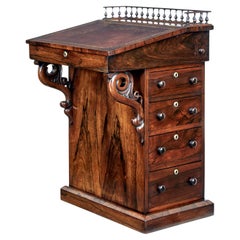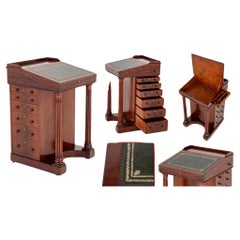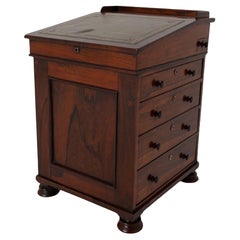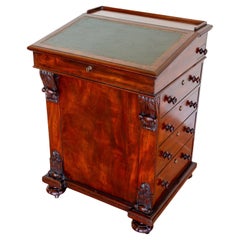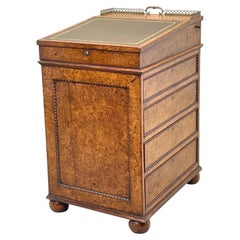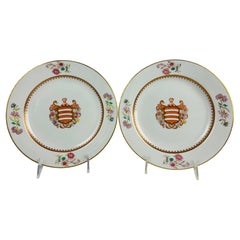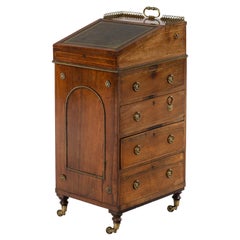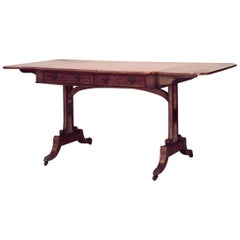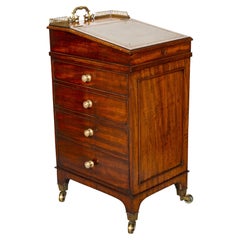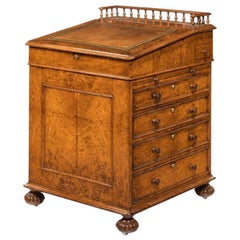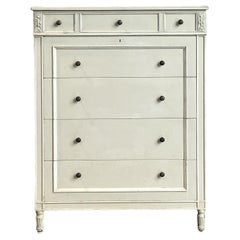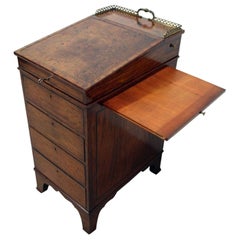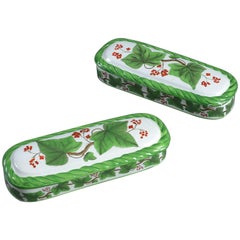Regency Davenport
Antique Early 19th Century English Regency Desks and Writing Tables
Leather, Palisander
Vintage 1980s Regency Desks
Mahogany
Antique 18th Century Regency Desks
Oak
Antique 1830s British Regency Desks and Writing Tables
Leather, Mahogany
Antique Early 19th Century English Regency Desks
Elm
Antique Early 19th Century English Regency Porcelain
Porcelain
Antique 19th Century English Regency Desks and Writing Tables
Leather, Wood
Antique Early 19th Century British Regency Console Tables
Brass
Antique Early 19th Century British Regency Secretaires
Mahogany
Antique 1790s English Regency Desks
Leather, Mahogany
Antique 1820s English Desks and Writing Tables
Oak
Mid-20th Century American Regency Commodes and Chests of Drawers
Wood, Paint
Mid-20th Century American Hollywood Regency Cabinets
Wood, Paint
Late 20th Century Regency Desks
Brass
Antique Early 19th Century English Regency Desks
Mahogany
Antique Early 19th Century British Regency Side Tables
Mahogany
Antique 19th Century English Regency Desks and Writing Tables
Satinwood
Antique 19th Century English Desks and Writing Tables
Leather, Boxwood, Rosewood
Antique Mid-19th Century English Regency Desks
Mahogany, Rosewood
Antique 1810s English Regency Desks
Leather, Hardwood
Antique Early 19th Century English Regency Desks
Mahogany
Antique Early 19th Century English Regency Desks and Writing Tables
Rosewood
Mid-20th Century American Hollywood Regency Vanities
Mirror, Wood
Antique 19th Century Regency Decorative Dishes and Vide-Poche
Porcelain
Antique 1810s English Regency Desks
Leather, Walnut
Recent Sales
Antique 1810s Regency Desks
Mahogany
Antique Early 19th Century English Regency Decorative Boxes
Porcelain
Antique Early 19th Century English Regency Platters and Serveware
Stoneware
Antique 1820s English Regency Soup Tureens
Stoneware
Antique 1820s Desks and Writing Tables
Antique Mid-19th Century Cabinets
Mahogany
Antique 1810s British Regency Desks
Rosewood
Antique Mid-19th Century Desks and Writing Tables
Antique 19th Century English Desks
Mahogany, Leather
Antique Early 19th Century English Regency Desks
Ebony, Mahogany
Antique Early 19th Century English Regency Desks and Writing Tables
Ebony, Oak
Antique Early 1800s English Regency Desks
Brass
Antique 1820s English Regency Secretaires
Leather, Mahogany
Antique 1810s English Regency Desks
Rosewood
Antique 1820s English Regency Decorative Boxes
Enamel, Gold Leaf
Antique Early 19th Century English Regency Pedestals
Wood, Mahogany
Antique Early 19th Century English Regency Desks and Writing Tables
Palisander
Antique 1840s English Desks and Writing Tables
Rosewood
Antique 19th Century English Regency Desks and Writing Tables
Rosewood
Antique Early 19th Century English Regency Desks
Palisander
Antique Early 19th Century English Regency Desks
Palisander
Antique Early 19th Century English Regency Ceramics
Porcelain
Antique 1810s English Regency Wine Coolers
Terracotta
Antique Early 19th Century Regency Desks
Brass
Antique 19th Century English Desks
Burl, Leather, Walnut
Antique 1820s English Regency Tea Sets
Porcelain
Antique 19th Century English Desks
Rosewood
Antique 1830s English Regency Dinner Plates
Porcelain
Antique Early 1800s British Regency Vases
Pottery
Antique Early 19th Century English Regency Desks and Writing Tables
Mahogany
Antique 19th Century European Regency Desks
Leather, Mahogany
Antique Early 19th Century English Regency Porcelain
Porcelain
Antique Early 19th Century English Regency Desks
Brass
Antique Early 19th Century English Regency Serving Pieces
Pearlware, Pottery
Antique Early 19th Century English Regency Desks and Writing Tables
Mahogany
Antique Late 19th Century English Regency Desks
Brass
Antique Mid-19th Century English Regency Soup Tureens
Ironstone
Antique Early 19th Century English Regency Serving Pieces
Earthenware
Antique Early 19th Century Great Britain (UK) Regency Desks and Writing ...
Oak
Antique Early 19th Century English Regency Decorative Dishes and Vide-Poche
Earthenware
Antique Early 19th Century Regency Ceramics
Ceramic, Pottery, Ironstone
Antique 1820s British Regency Desks
Mahogany
Antique 19th Century English Regency Vases
Ceramic, Porcelain
Antique 19th Century English George IV Desks and Writing Tables
Wood
Antique 1820s English Regency Tea Sets
Porcelain
Antique 1820s English Regency Dinner Plates
Porcelain
Antique Early 18th Century English Regency Decorative Dishes and Vide-Poche
Earthenware
Antique Early 19th Century Regency Soup Tureens
Ironstone
Antique 1830s English Regency Dinner Plates
Porcelain
Antique Early 19th Century English Regency Decorative Dishes and Vide-Poche
Porcelain
Antique 1810s English Regency Desks
Brass
Antique Early 19th Century English Desks
Mahogany
Antique 19th Century English Desks
Rosewood
Antique Early 19th Century English Regency Desks
Gold Leaf
Antique 19th Century English Desks and Writing Tables
Felt, Wood, Mahogany
Antique 19th Century British Regency Desks and Writing Tables
Rosewood
Antique 19th Century American Regency Secretaires
Mahogany
People Also Browsed
Antique 19th Century French Louis XVI Sofas
Walnut
20th Century Moroccan Moorish Lanterns
Metal
Antique Late 19th Century European Moorish Architectural Elements
Wrought Iron
Late 20th Century Italian Baroque Sterling Silver
Sterling Silver
Mid-20th Century English Dinner Plates
Porcelain
Vintage 1980s Empire Console Tables
Marble, Bronze
20th Century American Arts and Crafts Table Lamps
Stained Glass
Antique Late 19th Century English Gothic Doors and Gates
Metal, Iron, Wrought Iron
Vintage 1980s Regency Bookcases
Walnut
2010s British Louis XV Sofas
Hardwood
Vintage 1920s French Louis XVI Vitrines
Brass
20th Century American Arts and Crafts Table Lamps
Stained Glass
Vintage 1960s Art Deco Table Lamps
Stained Glass
20th Century English Medieval Windows
Lead
Early 20th Century Spanish Neoclassical Chandeliers and Pendants
Bronze
20th Century American Arts and Crafts Table Lamps
Stained Glass
